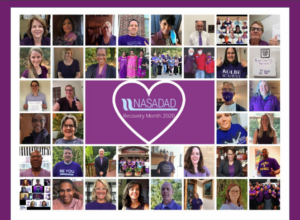During the month of September, National Recovery Month, NASADAD Members, Component Group Members, and Staff submitted pictures of themselves wearing purple to help celebrate recovery and spread awareness of substance use disorder issues. Many thanks to Jen Smith (SSA, PA), Secretary and Region III representative on NASADAD’s Board of Directors, for developing this idea.
Cassandra Price (SSA, GA), NASADAD President, included with her picture this note: “Sporting my purple in support of Recovery Month 2020! Congratulations to all of those in recovery and continued unwavering hope for those searching for the path towards recovery. Never give up!”
NASADAD is grateful for the work State Director’s did in their respective States throughout the month of September, and for their ongoing efforts to support recovery every day of the year.
